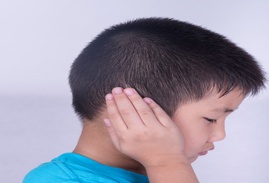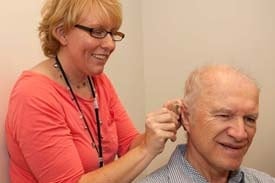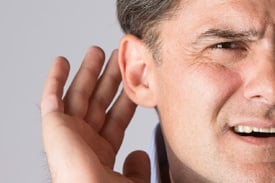Did you know the most frequent pediatrician visits, other than for well-child care, are for ear problems? And, did you know that the most common surgery performed on children in the U.S. is for “tubes in the ears,” which refers to Tympanostomy tube (myringotomy with pressure equalization – “PE tube”) placement is the most common surgery performed on children in the United States
My Child Needs Tubes in His Ears - What Does That Mean?
Tags: Hearing, Hearing Loss, toddler
10 Reasons to Visit the Community Center for the Deaf and Hard of Hearing
There are countless reasons why the Community Center for the Deaf and Hard of Hearing (CCDHH) is a wonderful resource for Deaf individuals as well as those who want to learn more about Deaf culture.
Tags: Language, Communication, Teens, Support, Deaf, Hard of Hearing, Hearing Loss, American Sign Language, Interpreting, ASL Interpreter, ASL, Learning
Top 10 Tips to Adjust to New Hearing Aids
For most people, hearing loss occurs very gradually. The process of getting hearing aids, however, is not gradual. You walk into the audiologist's office, and a few minutes later you're hearing! It takes the brain time to get adjusted to the new sounds you'll be hearing through the hearing aids. To make the adjustment process a little easier, start with easy situations and work your way up to more difficult listening environments.
Tags: Hearing Aid, Audiology, Hearing Aids, Hearing, Hard of Hearing, Hearing Loss
Communication Strategies for People with Hearing Loss
Hearing loss may make conversational speech seem very soft, or may prevent a person from hearing certain speech sounds at all. This is why people with hearing loss often say they can hear people talking, but can’t understand what they’re saying. They may be able to hear some sounds, so they can hear the person’s voice, but the hearing loss is blocking out the sounds that are vital to understanding. Usually, when a person is diagnosed with a hearing loss, hearing aids are recommended. Hearing aids are designed to amplify the sounds that the person needs the most, the sounds that they are unable to hear due to the hearing loss. Unfortunately, hearing aids have limitations and will not restore hearing to normal. Hearing aids are only part of the hearing loss puzzle. The best solution to increase hearing and understanding at the same time is to pair hearing aids with effective communication strategies.
Tags: Hearing Aid, Hearing Aids, Communication, Hearing, Hard of Hearing, Hearing Loss
Buying Hearing Aids: CHSC Audiologists vs. Online or Over the Counter
Cleveland Hearing & Speech Center audiologists are highly trained professionals. We have Doctoral and Master’s degrees in audiology and we have devoted our careers to helping you hear better. At CHSC, We believe that life is improved by successful communication. We are dedicated to helping people hear better so they can fully enjoy the people and activities that bring meaning to each day.
Tags: Hearing Aid, Audiology, Hearing Aids, Communication, Support, Hard of Hearing, Hearing Loss
Ordering Your Hearing Aids
Your Cleveland Hearing & Speech Center (CHSC) audiologist can place an order for your hearing aids. Before you can order a hearing aid, you must have your hearing tested. Once this testing is done, you should talk with your audiologist to decide which hearing aids are best for you, your hearing loss, and your lifestyle. Next, the audiologist will take an impression of your ear. During this process, she will put a putty-like material in your ear for about five to ten minutes. This material will harden to the shape of your ear so the hearing aid company can make your custom hearing aid.
Tags: Hearing Aid, Audiology, Hearing Aids, Hearing, Hearing Loss
Causes & Treatment of Infant Hearing Loss
Infant hearing loss affects approximately 2-3 out of 1,000 live births (NIDCD).
Tags: Audiology, Hearing, Hearing Loss Prevention, Support, Hearing Loss
What is Hearing Loss?
Impairments in hearing can happen in either frequency (the high or low pitch of a sound) or intensity (the volume of a sound), or both. For example, a person may not be able to hear very high-pitched noises like a whistle, or they may not be able to hear the TV unless the volume is turned up – or both. Hearing loss severity is based on how well a person can hear the frequency or intensities most often associated with speech. Severity can be described as mild, moderate, sever, or profound. Hearing loss can be congenital (occurring from the time of birth) or acquired (developing later in life after a period of normal hearing). Hearing loss can affect one or both ears – and in different degrees of severity in each ear. A loss that affects one ear is called a “unilateral” (one-sided) hearing loss. A loss that affects both ears is called a bilateral (two-sided) hearing loss.
Tags: Audiology, Hearing Aids, Hearing, Hard of Hearing, Hearing Loss
Assistive Listening Devices Can Boost Your Hearing
When your hearing aids do not provide enough help in certain environments, or if you don’t wear hearing aids but need help hearing only in certain situations, you may want to consider an assistive or alerting device. Discuss with your audiologist which devices might be helpful to you. At CHSC, we offer a variety of devices and can you determine which is right for you.
Tags: Audiology, Hearing Aids, Communication, Hearing, Hearing Loss
How Hearing Works
The outer ear is what most people consider “the ear.” It consists of a flap of skin/cartilage (called the pinna or auricle) on the outside of the head. It collects sound and directs it into the ear canal. The ear canal is a closed tube with hairs and “wax glands” in the outer portion. Our ear canal is self-cleaning. The wax glands produce wax, or cerumen, and the tiny hairs push the wax out of our ears. As the wax moves out of the ear, it cleans the ear canal and keeps unwanted critters, such as insects, out of the ear. At the end of the ear canal is the eardrum, or tympanic membrane. When air moves it creates vibrations. These sound vibrations are collected by the pinna and directed into the ear canal, to the eardrum, causing it to vibrate just like the head of a drum when you hit it with a drumstick. When an audiologist or physician looks into a healthy, unobstructed ear with an otoscope, s/he can see the outer surface of the eardrum.
Tags: Audiology, Communication, Hearing, Hearing Loss















